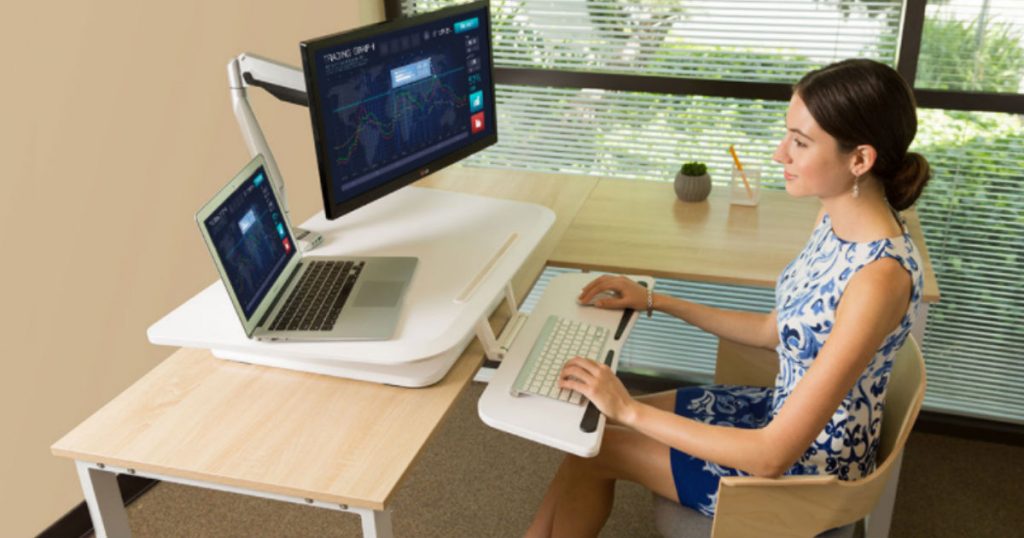The best standing desk helps you to work without compromising on the consistency of your work while standing. It should also have workplace accessories that improve organic movement and proper postures for sitting and standing. If the jobs stay productive, the organisation’s total productivity is likely to improve.
There are many benefits to purchase a standing desk (sometimes referred to as stand up desks, sit-stand desks, or sit-to-stand desks), but there are so many alternatives that it may be a struggle to choose the right fit for your needs.
Your aim should be to switch regularly during the day, to frequently alter postures, and a good flexible desk is a tool to help you do that. Standing all the time is no better for certain people, and maybe much worse, than sitting all the time. In reality, it’s doing one or the other, which becomes a challenge. It will become a great tool on your journey towards enhanced work convenience, efficiency, and your overall health and well-being if you chose an adjustable workstation. If you choose a portable workstation that satisfies all your requirements for work and well-being, height modification is strongly recommended.
If you get a new desk or a device that sits on top of the current one is largely a matter of convenience, but you can still take into account the usable space, as well as the surface space you need to work effectively. Consider the “footprint” that either a desk or a desk-top unit would fill, as well as the screen work surface area your preference will provide, as you think about your office. A full desk could be a safer option if you want to spread stuff out and keep a lot of elbow space. If there is no need for sufficient desk surface area, then a desktop sit-stand unit could be the perfect solution.
In terms of features, also consider the compatibility with your other office equipment and furniture.
Invest in a table, desk, or laptop device that adapts to various standing heights. For safe and productive output as well as long-term well-being, they provide the greatest stability and assistance. You mayEach desk on the market has its own specific set of modifications, so you need to pick one that suits you. Make sure to remember factors such as the width of the surface of the table/desk, the height of the surface of the keyboard sitting atop the desk, the height of the shoe, the thickness of floor mats, or something else that may impact these heights.
An adjustable keyboard tray that can adjust lower than the desk height might be suitable if you are a shorter person or need to accommodate shorter people as they operate in a seated position. Like a footrest, by using an anti-fatigue mat, standing users also report greater relaxation, so it can be a welcome addition to your work space.
With your upper arm lying on your sides and your forearm extended as though you were typing on your keyboard (do not reach out, remain comfortable!), sit comfortably in your chair, feet flat on the floor while wearing comfortable shoes, and calculate the distance from the ground to the underside of your elbow. Your keyboard height should be at or below about the height while operating. Get up to get the same measurement taken. Often remember the height when taking this calculation if you plan to use an anti-fatigue floor pad. If you are a smaller individual and cannot locate a table that is reasonably short, try attaching a footrest or an adjustable height keyboard tray to your workstation.
Do not skimp on the width of the desk, meaning the distance from the front-to-back tabletop when you approach the desk. Many desks are accessible with a depth of at least 30 degrees, which for most consumers is sufficient. Anything less would push the display closer to the person, theoretically reducing visual performance and causing eye pressure or irritation, which can affect visual habits and capabilities. Adjustable desks and tables, including L-forms, come in several different sizes and shapes, so select the right one for your work patterns and needs.
As long as you obey the other recommendations, it is highly recommended to be electric or pneumatic. In general, crank modifications take many too many “cranks” to have them calibrated correctly, and few people have the ability to use them. However, a crank will work just fine if you prefer a standing/perching configuration, as the adjustment range is minimal.
There is a weight capacity for each adjustable desk, and most versions have plenty of capacity for traditional desktop products. If you expect a need to find heavy objects on the desktop, however, be sure to pay attention to weight ability.
It may not be an absolute must, but a flexible display arm that allows you a number of longitudinal, lateral, angular and rotational variations is highly recommended. Adjustable display weapons let you do far more than set your monitor at a certain height; they also give you the ability to change your monitor to lighting or glare conditions, adjust heights and angles and viewing depths to alleviate eye strain and enhance visual performance, and allow multiple users to comfortably adjust to their own viewing preferences. They are also great for teamwork and customer support, offering flexibility for multiple angles and orientations of observation.
You may also want to purchase your own diy standing desk kit to make your own standing desk. This is sometimes cheaper than buying an actual standing desk.
Unless you are one of the few people who can stand happily all day, you will need a chair at your computer workstation. Instead of an expensive high-end chair with all the bells and whistles to help sedentary staff, an active workstation and work patterns might promote a sit-stand arrangement to mitigate some of the need.
